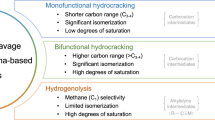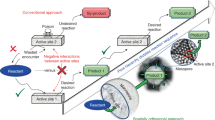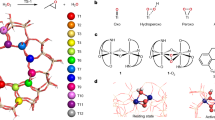Abstract
Terminally oxidized hydrocarbons are of considerable interest as potential feedstocks for the chemical and pharmaceutical industry, but the selective oxidation of only the terminal methyl groups in alkanes remains a challenging task. It is accomplished with high efficiency and selectivity by some enzymes; but inorganic catalysts, although inferior in overall performance under benign conditions, offer significant advantages from a processing standpoint1. Controlled partial oxidation is easier to achieve with ‘sacrificial’ oxidants, such as hydrogen peroxide2, alkyl hydroperoxides oriodosylbenzene3, than with molecular oxygen or air. These sacrificial oxidants, themselves the product of oxidation reactions, have been used in catalytic systems involving tailored transition-metal complexes in either a homogeneous state4,5,6, encapsulated in molecular sieves7,8,9 or anchored to the inner surfaces of porous siliceous supports10. Here we report the design and performance of two aluminophosphate molecular sieves containing isolated, four-coordinated Co(III) or Mn(III) ions that are substituted into the framework and act, in concert with the surrounding framework structure, as regioselective catalysts for the oxidation of linear alkanes by molecular oxygen. The catalysts operate at temperatures between 373 K and 403 K through a classical free-radical chain-autoxidation mechanism. They are thus able to use molecular oxygen as oxidant, which, in combination with their good overall performance, raises the prospect of using this type of selective inorganic catalyst for industrial oxidation processes.
This is a preview of subscription content, access via your institution
Access options
Subscribe to this journal
Receive 51 print issues and online access
$199.00 per year
only $3.90 per issue
Buy this article
- Purchase on Springer Link
- Instant access to full article PDF
Prices may be subject to local taxes which are calculated during checkout



Similar content being viewed by others
References
Hill, C. L. (ed.) Activation and Functionalisation of AlkanesCh. 6–8 (Wiley, Chichester, (1989).
Tatsumi, T., Nakamura, M., Negishi, S. & Tominaga, H. Shape-selective oxidation of alkanes with H2O2catalysed by titanosilicate. J. Chem. Soc. Chem. Commun. 476–477 (1990).
Smegal, J. A. & Hill, C. L. Hydrocarbon functionalisation by the (iodosylbenzene) manganese(IV) porphyrin complexes from the (tetraphenylporphyrinato) manganese(III)-iodosylbenzene catalytic hydrocarbon oxidation system. Mechanism and reaction chemistry. J. Am. Chem. Soc. 105, 3515–3521 (1983).
Cook, B. R., Reinert, T. J. & Suslick, T. S. Shape selective alkane hydroxylation by metalloporphyrin catalysts. J. Am. Chem. Soc. 108, 7281–7286 (1986).
Mansuy, D. Cytochrome-P450 and synthetic models. Pure Appl. Chem. 59, 759–770 (1987).
Lyons, J. E., Ellis, P. E. J & Myers, W. K. J Halogenated metalloporphyrin complexes as catalysts for selective reactions of acyclic alkanes with molecular oxygen. J. Catal. 155, 59–73 (1995).
Herron, N. & Tolman, C. A. Ahighly selective zeolite catalyst for hydrocarbon oxidation—a completely inorganic mimic of the alkane omega-hydroxylases. J. Am. Chem. Soc. 109, 2837–2839 (1987).
Raja, R. & Ratnasamy, P. Process for the oxidation of cyclohexane to a mixture of cyclohexanol and cyclohexanone. US PatentNo. 5,767,320 (1998).
Raja, R. & Ratnasamy, P. Selective oxidation with copper complexes incorporated in molecular sieves. Stud. Surf. Sci. Catal. 101, 181–190 (1996).
Maschmeyer, T. et al. Designing a solid catalyst for the selective low-temperature oxidation of cyclohexane to cyclohexanone. Angew. Chem. Int. Edn 36, 1639–1642 (1997).
Thomas, J. M. et al. On the nature of the active site in a CoAPO-18 solid acid catalyst. Angew. Chem. Int. Edn 33, 1871–1873 (1994).
Barrett, P. A., Sankar, G., Catlow, C. R. A. & Thomas, J. M. X-ray absorption spectroscopic study of Brönsted, Lewis and redox centres in cobalt-substituted aluminium phosphate catalysts. J. Phys. Chem. 100, 8977–8985 (1996).
Iton, L. E., Choi, I., Desjardins, J. A. & Maroni, V. A. Stabilisation of Co(III) in aluminophosphate molecular sieve frameworks. Zeolites 9, 535–538 (1989).
Lin, S. S. & Weng, H. S. Liquid-phase oxidation of cyclohexane over CoAPO-5: Synergism effect of coreactant and solvent effect. Appl. Catal. 118, 21–31 (1994).
Krauschaar-Czarnetzki, B., Hoogervorst, W. G. M. & Stork, W. H. J. Oxidation of saturated hydrocarbons involving CoAPO molecular sieves as oxidants and as catalysts. Stud. Surf. Sci. Catal. 84, 1869–1876 (1994).
Tolman, C. A., Druliner, J. D., Nappa, M. J. & Herron, N. in Activation and Functionalization of Alkanes (ed. Hill, C. L.) 303–360 (Wiley, Chichester, (1989).
Kerr, J. A. Bond dissociation energies by kinetic methods. Chem. Rev. 66, 465–498 (1966).
Chen, J. & Thomas, J. M. MAPO-18 (M- Mg, Zn, Co)—A new family of catalysts for the conversion of methanol to light olefins. J. Chem. Soc. Chem. Commun. 603–604 (1994).
Thomas, J. M. The ineluctable need for in-situ methods of characterising solid catalysts as a prerequisite to engineering active sites. Eur. J. Chem. 3, 1557–1562 (1997).
Vanoppen, D. L., De Vos, D., Genet, M. J., Rouxhet, P. G. & Jacobs, P. A. Cobalt-containing molecular-sieves as catalysts for the low conversion autoxidation of pure cyclohexane. Angew. Chem. Int. Edn 34, 560–563 (1995).
Sankar, G., Raja, R. & Thomas, J. M. Redox solid catalysts for the selective oxidation of cyclohexane in air. Cat. Lett. 55, 15–23 (1998).
Thomas, J. M. & Thomas, W. J. Introduction to the Principles of Heterogeneous Catalysis 383–384 (Academic, London, (1967).
Groves, J. T. Artificial enzymes—the importance of being selective. Nature 389, 329–330 (1997).
Ludwig, M. L., Metzger, A. L., Pattridge, K. A. & Stallings, W. C. Manganese superoxide dismutase from Thermus thermophilus—a structural model refined at 1.8 å resolution. J. Mol. Biol. 219, 335–358 (1991).
Barrett, P. A., Sankar, G., Jones, R. H., Catlow, C. R. A. & Thomas, J. M. Interaction of acetonitrile with cobalt-containing aluminophosphates: an x-ray absorption investigation. J. Phys. Chem. 101, 9555–9562 (1997).
Freeman, C. M., Catlow, C. R. A., Thomas, J. M. & Brode, S. Computing the location and energetics of organic molecules in microporous adsorbents and catalysts—hybrid approach applied to isomeric butenes in a model zeolite. Chem. Phys. Lett. 186, 137–142 (1991).
Morohashi, K., Sadano, H., Okada, Y. & Omura, T. Position specificity in n-hexane hydroxylation by two forms of cytochrome P-450 in rat liver microsomes. J. Biochem. 93, 413–419 (1983).
Hamberg, M., Samuelsson, B., Bjorkhem, I. & Danielsson, H. in Molecular Mechanisms of Oyxgen Activation (ed. Hayaishi, O.) 24–52 (Academic, New York, (1974).
Binsted, N. EXCURV 98 (CCLRC Daresbury Lab., (1998).
Acknowledgements
We thank D. W. Lewis for discussions. We also thank the UK EPSRC for a rolling grant (J.M.T.) and the Royal Commission for the Exhibition of 1851 for a research fellowship (R.R.). Molecular Simulation Inc. (MSI) is acknowledged for the provision of molecular modelling software.
Author information
Authors and Affiliations
Supplementary information
Supplementary Information
Supplementary Information (PDF 716 kb)
Rights and permissions
About this article
Cite this article
Thomas, J., Raja, R., Sankar, G. et al. Molecular-sieve catalysts for the selective oxidation of linear alkanes by molecular oxygen. Nature 398, 227–230 (1999). https://doi.org/10.1038/18417
Received:
Accepted:
Issue Date:
DOI: https://doi.org/10.1038/18417
This article is cited by
-
Ultrasound-assisted co-precipitation synthesis of mesoporous Co3O4−CeO2 composite oxides for highly selective catalytic oxidation of cyclohexane
Frontiers of Chemical Science and Engineering (2022)
-
Highly crystalline core dominated the catalytic performance of carbon dot for cyclohexane to adipic acid reaction
Nano Research (2022)
-
Preparation, characterization and catalytic performance of polyoxometalate immobilized on the surface of halloysite
Journal of Materials Science (2019)
-
Cyclohexane photooxidation under visible light irradiation by WO3–TiO2 mixed catalysts
Research on Chemical Intermediates (2018)
-
Electrochemical Hydroxylation of C3–C12 n-Alkanes by Recombinant Alkane Hydroxylase (AlkB) and Rubredoxin-2 (AlkG) from Pseudomonas putida GPo1
Scientific Reports (2017)
Comments
By submitting a comment you agree to abide by our Terms and Community Guidelines. If you find something abusive or that does not comply with our terms or guidelines please flag it as inappropriate.



